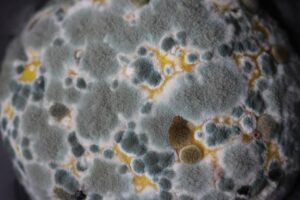Difference Between Mold & Seasonal Allergies
 Mold and seasonal allergies have many of the same symptoms as other allergies; making a diagnosis is challenging but very important since one of them (mold allergies) can cause serious damage to your body. If you feel your allergies are more severe than seasonal allergies and medicine isn’t working, have an expert consultant test your business, home, or school for mold. However, you cannot eliminate mold, but eradicating it from your home or workplace is a significant step in the right direction.
Mold and seasonal allergies have many of the same symptoms as other allergies; making a diagnosis is challenging but very important since one of them (mold allergies) can cause serious damage to your body. If you feel your allergies are more severe than seasonal allergies and medicine isn’t working, have an expert consultant test your business, home, or school for mold. However, you cannot eliminate mold, but eradicating it from your home or workplace is a significant step in the right direction.
Ragweed, pollen, and seasonal allergies could be the cause of your coughing, eye irritation, nasal congestion, and tickling throat. Mold could be playing a greater role than you know for many people with allergies, especially if you had a water leak from the rain this summer. People are discovering mold growing within their ceilings and walls where the leakage occurred. Now that the weather is slowly getting colder, water from roof leaks can provide moisture to the surfaces, resulting in a suitable environment for mold growth, which might cause mold allergies in the future.
You can avoid these problems by hiring a certified indoor air quality testing service in Long Beach, Los Angeles. They will conduct a comprehensive inspection of your house to determine the source of the pollution. Once located, they will assist you in making the best decision to keep your family and home protected.
Difference Between Mold & Seasonal Allergies
Mold allergies are treated with the same drugs that are used to treat seasonal allergies. Allergy is alleviated with decongestants, nasal sprays, and antihistamines. Mold allergies can be treated with prescription medication.
What Exactly Is a Mold Allergy?
If you have a seasonal allergy, you may be allergic to mold or other fungal spores. Molds are found everywhere. Disturbing a mold source might release spores into the air. Fungi are mold and mildew. They grow and develop differently from animals or plants. Spores are “seeds” that move through the air. Many spores propagate in dry, windy conditions. When the humidity is high, others spread with dew or fog. Some people are allergic to spores after inhaling them. From July until early September, allergic reactions to fungal spores are most prevalent. However, because fungus may thrive in various environments, both indoors and outdoors, allergic responses can develop at any time of year.
While there are many different kinds of mold, only a few hundred of them cause allergic responses. Molds can be found on fallen leaves, compost piles, rotting logs, and grains or grasses.
Molds, unlike pollen, do not disappear with the first fatal frost. During the winter, some outdoor molds go dormant. They appear in the spring on plants that have been destroyed by the winter. Fungi thrive in moist environments. They are frequently discovered in the kitchen, basement, and bathroom.
What Exactly Is a Seasonal Allergy?
Seasonal allergies are most common during early February till early October, although mold allergies can affect all year. Also note, that ragweed season, which comes between midsummer and mid-fall, is a common source of symptoms.
Please note that ragweed season, which comes between midsummer and mid-fall, is a common source of symptoms. Furthermore, seasonal allergies typically impact people outdoors or have their windows open, whereas mold allergies typically impact people when they are indoors and have their windows closed.
If you go outside, wear a dust mask and sunglasses. Open the windows pulled up and the AC on while driving. Return indoors, change your clothes, and shower to remove pollen from your hair and skin. Using an air cleaning filter can assist in keeping the air clean.
Methods of Prevention for Mold Allergies
To avoid mold allergies, try to keep home mildew to a limit by:
- At least once a month, clean the bathroom, including the shower, bathtub, shower curtains, and windowsills, by using disinfectant or bleach.
- Carpet removal from floors.
- Moisture may be vented by installing exhaust fans in laundry rooms, bathrooms, and kitchens.
- Examine under sinks for leakage regularly since standing water may cause mold to spread fast.
- Use a dehumidifier in wet areas of your house and set it to 60% humidity.
- Mold allergies aren’t limited to the home. Keep yourself protected even when outdoors.
- Take care of organic material in your drains and garden. Mold thrives in heaps of lawn residues, such as decaying leaves.
Method of Prevention For Seasonal Allergies
Try to avoid pollen exposure through:
- On dry and windy days or when pollen levels are high, stay indoors.
- Reassigning yard tasks, such as weed picking and grass mowing, to others who are not sensitive or using a pollen cover.
- Take off any clothes you’ve used outdoors and bathe as soon as possible.
- Don’t hang your clothes outside.
- Closing windows and doors, especially in the morning when pollen concentrations are high.
- Using the air conditioner in both the automobile and the house.
- Rugs and carpets should be cleaned regularly.
- Bathing indoor/outdoor pets regularly.
Conclusion
As a leading mold inspection service, 911 Restoration of Long Beach has all of the appropriate equipment and skills in mold examinations and screening to provide you with mold inspections that are guaranteed to be timely and accurate. Experts will be able to detect whether pollutants exist or not in your house and assist you in resolving these concerns in a fast and professional approach. Give us a call today!



